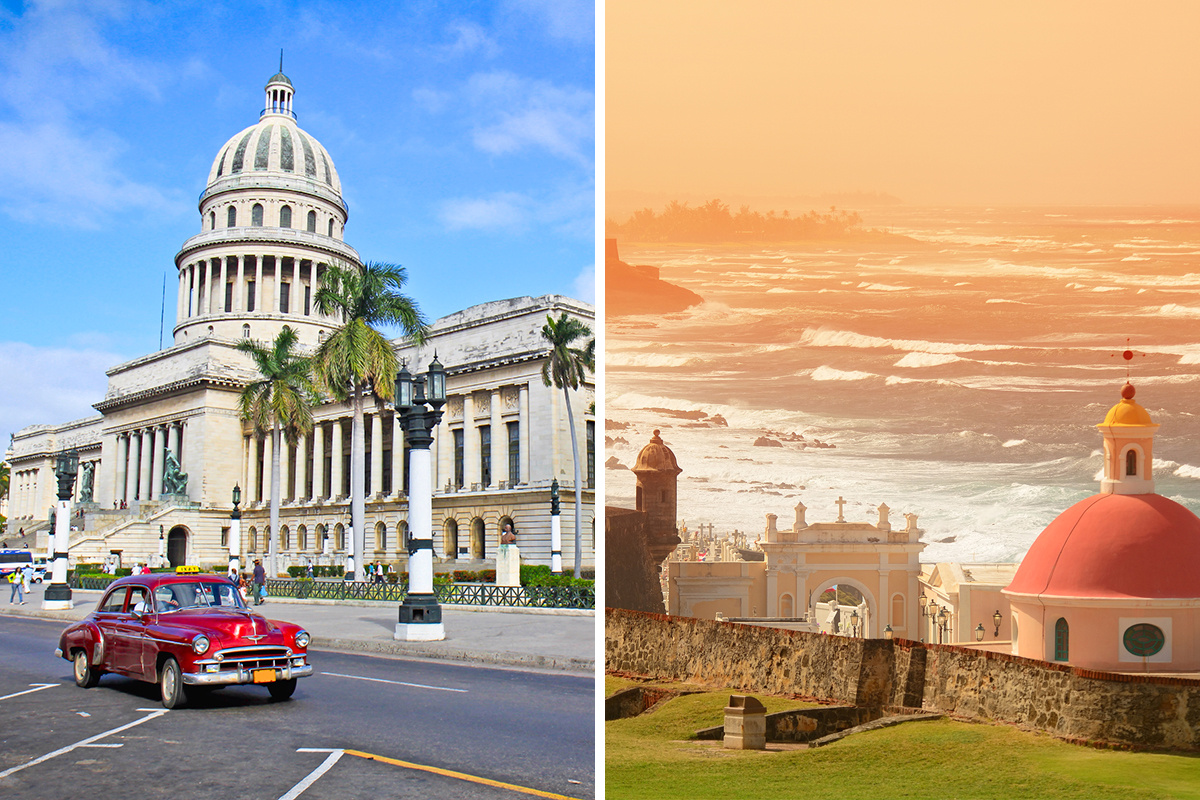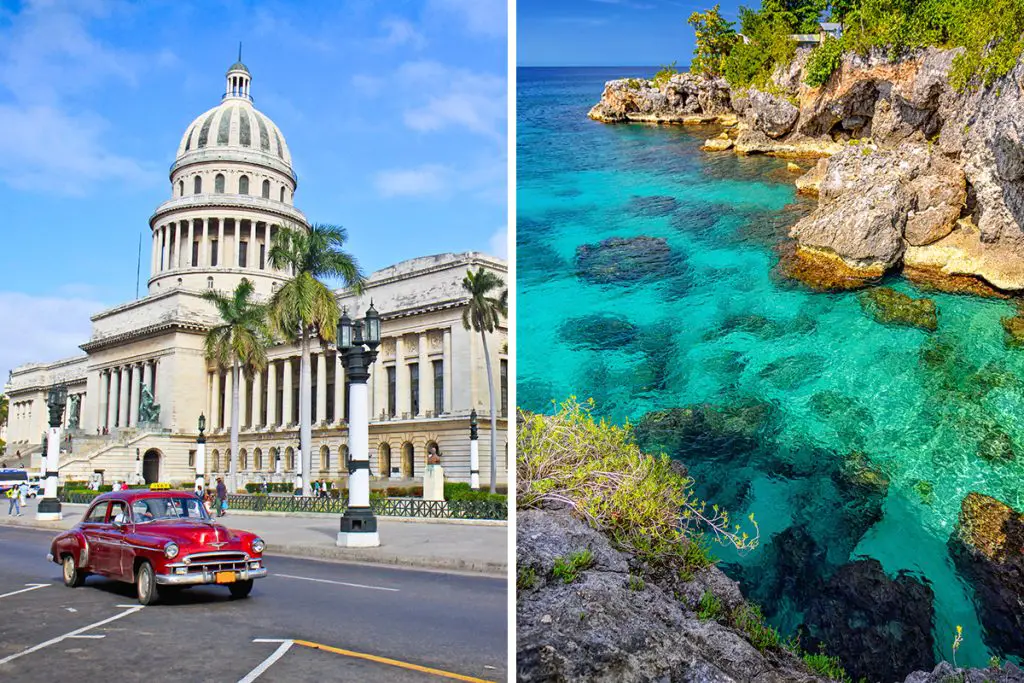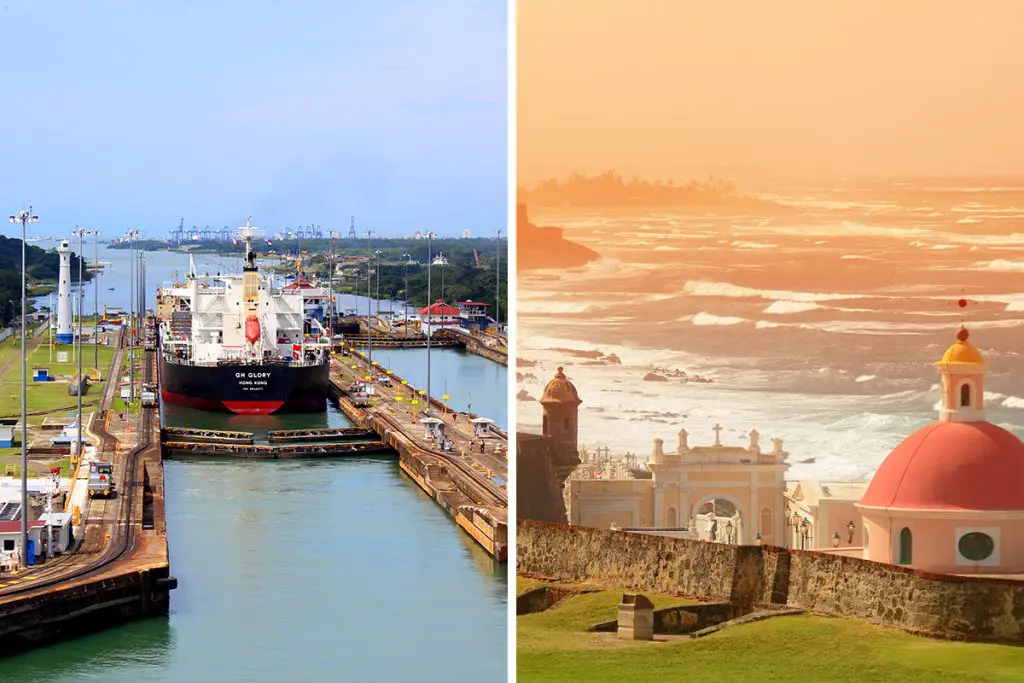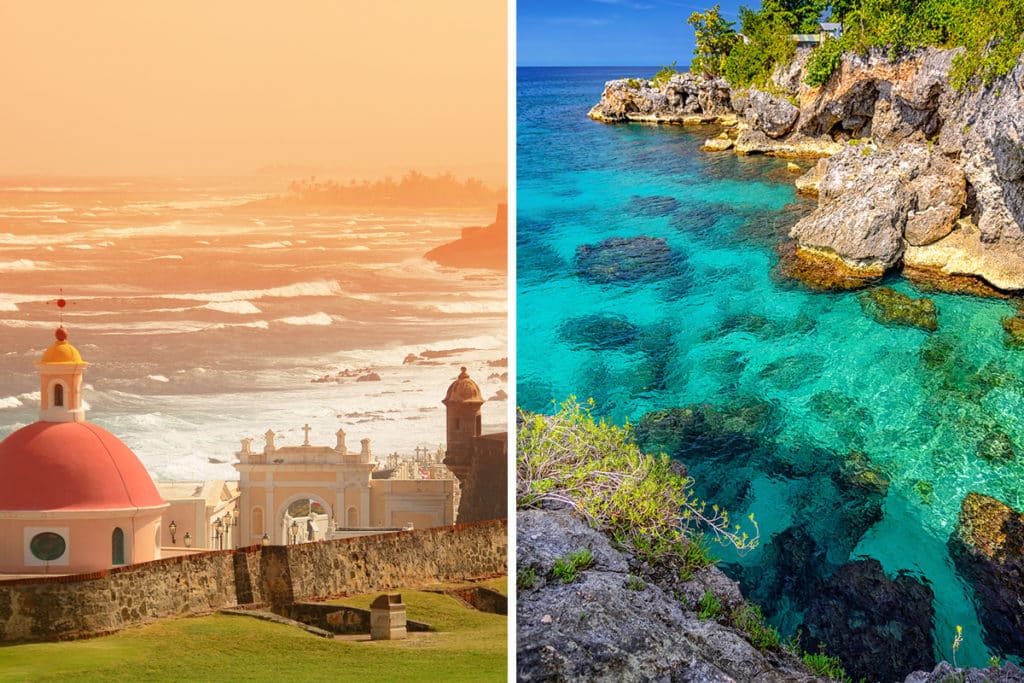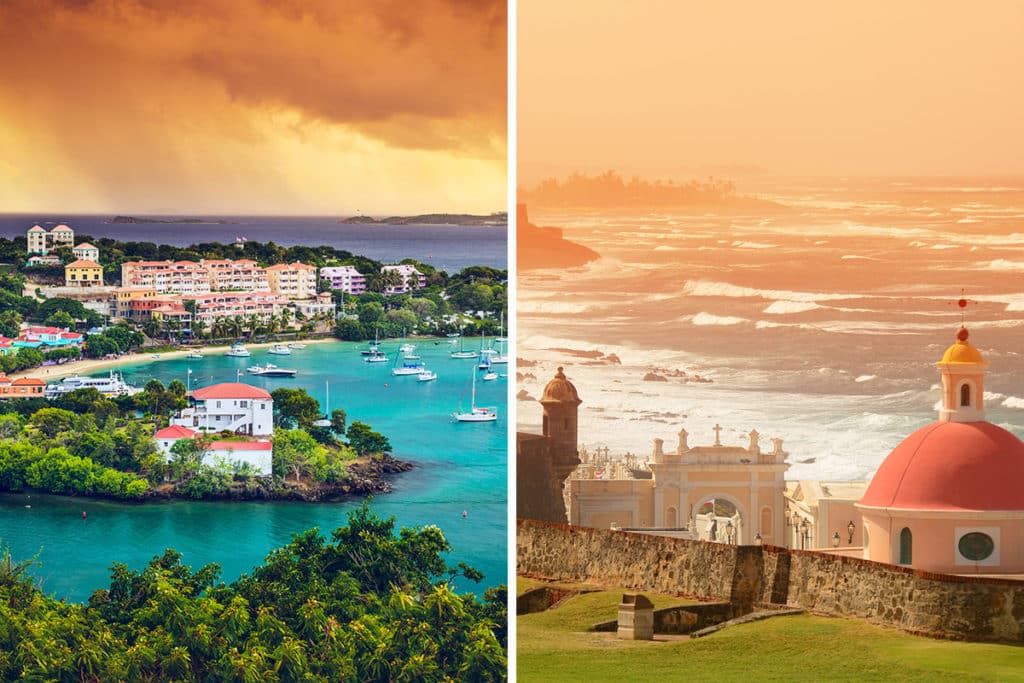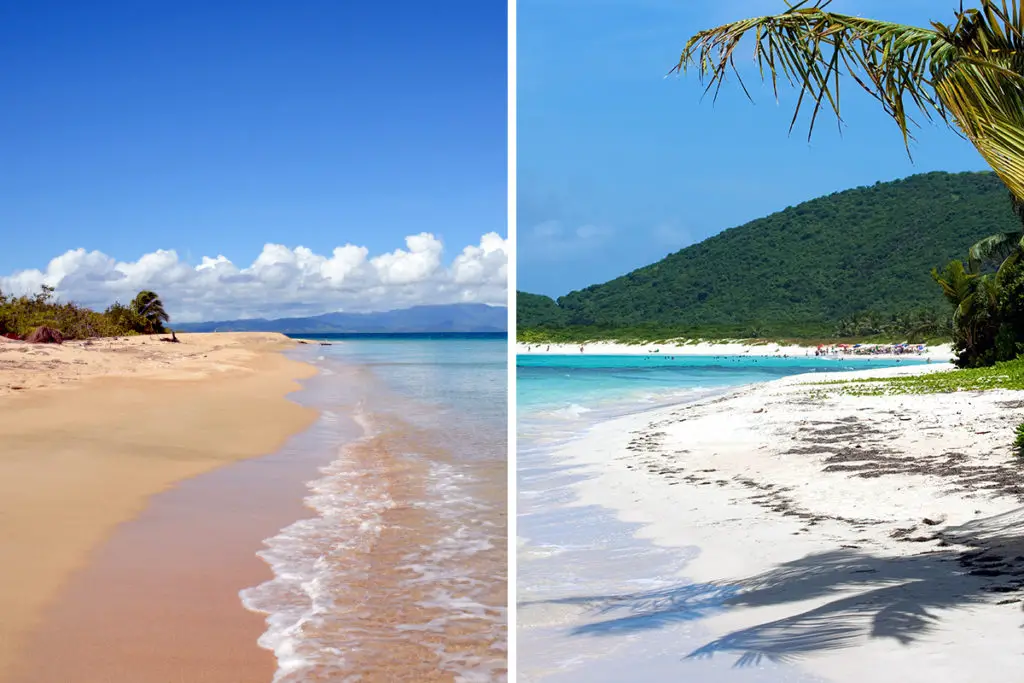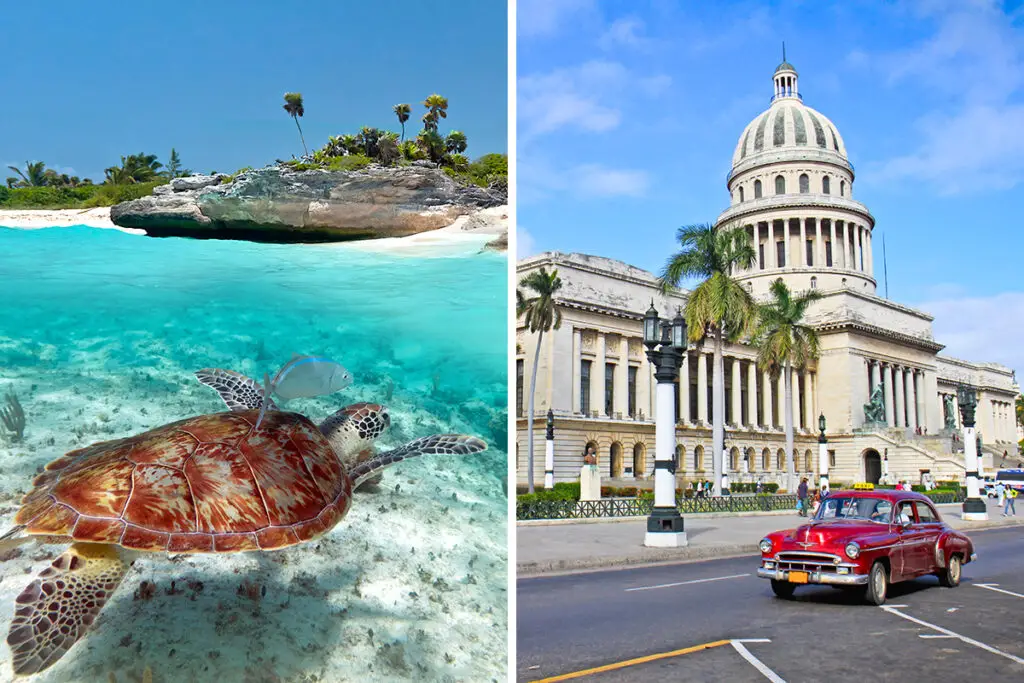Each destination has its own distinct charm and attractions that cater to different interests. In this comparison, we’ll dive into the details of what Cuba and Puerto Rico have to offer. Keep reading to learn more about these two incredible islands and find out which one is the ideal destination for your next vacation.
History & Culture
Cuba and Puerto Rico both have fascinating histories and vibrant cultures that attract travelers worldwide. Let’s explore the unique features of each destination to help you decide which island best suits your interests.
Cuba’s history is a tapestry of Spanish colonialism, African influences, and the communist revolution. The architecture in cities like Havana reflects this rich past, showcasing a mix of Spanish colonial buildings and mid-century modern structures.
The nation’s culture is known for its music, particularly salsa and Afro-Cuban jazz, which you can enjoy during street performances or at local clubs.
On the other hand, Puerto Rico’s history is a blend of Spanish, African, and indigenous Taíno influences. Spanish colonial architecture is also prominent in Old San Juan, a UNESCO World Heritage site. The island’s culture is diverse, with a lively arts scene and a strong tradition of dance, particularly bomba and plena, which you can see at festivals and cultural events.
Cuban art is another captivating aspect of its culture. Murals and sculptures are common throughout the country, reflecting both political and social themes. Cuban artists have gained international recognition for their unique styles and thought-provoking work.
Puerto Rican art, like its Cuban counterpart, displays a mix of indigenous, African, and European influences. Museums and galleries across the island showcase both traditional and contemporary works by local artists. Street art is also prevalent in Puerto Rico, adding a colorful flair to the urban landscape.
Language is another aspect to consider. In Cuba, Spanish is the primary language, but you may also encounter some English speakers in tourist areas. Puerto Rico, being a U.S. territory, is predominantly Spanish-speaking, but many residents are bilingual in English and Spanish, making communication easier for English-speaking visitors.
In summary, both Cuba and Puerto Rico offer rich historical and cultural experiences. Cuba’s revolutionary history and unique political landscape make it an intriguing destination, while Puerto Rico’s blend of Spanish, African, and indigenous influences provides a diverse cultural experience.
Attractions & Activities
Cuba and Puerto Rico have a variety of attractions and activities to suit all types of travelers. Let’s explore what each island has to offer beyond their stunning beaches.
In Cuba, history buffs will enjoy exploring Old Havana, a UNESCO World Heritage site full of colonial buildings, plazas, and museums. Nature lovers can venture to Viñales Valley, renowned for its picturesque limestone cliffs and tobacco fields.
For a more adventurous experience, consider hiking in the Escambray Mountains or exploring the Zapata Peninsula’s wetlands and wildlife.
Puerto Rico offers its own unique attractions, such as the El Yunque National Forest, the only tropical rainforest in the U.S. National Forest System. Hike through lush greenery, discover waterfalls, and spot the island’s diverse flora and fauna.
History enthusiasts will love Old San Juan, with its well-preserved Spanish colonial architecture and historic forts like El Morro and San Cristóbal.
Cuba’s classic car culture is an iconic part of the island’s identity. A ride in a vintage American car through the streets of Havana is a must-do activity. Additionally, consider taking a guided walking tour to learn about the country’s history and culture, or a dance class to learn salsa from local instructors.
Puerto Rico has its own unique activities, such as exploring the Camuy River Cave Park, one of the world’s largest cave networks, or kayaking in bioluminescent bays like Mosquito Bay or Laguna Grande, where microorganisms light up the water at night.
In conclusion, both Cuba and Puerto Rico offer a wide range of attractions and activities. Cuba’s vintage charm and revolutionary history make it a fascinating destination, while Puerto Rico’s diverse natural beauty and accessible adventures cater to all types of travelers. Whether you’re interested in exploring historic sites, immersing yourself in local culture, or embarking on outdoor excursions, both destinations have plenty to offer.
Beaches
Beaches are an essential part of any island vacation. Both Cuba and Puerto Rico boast stunning coastlines with unique characteristics.
Cuban beaches are known for their white sands and crystal-clear waters. Varadero Beach is a popular choice, stretching over 12 miles (19 kilometers). However, many smaller, more secluded beaches can be found throughout the island.
Puerto Rico, on the other hand, offers a diverse mix of beaches. You’ll find golden sands in some areas and black volcanic sands in others. Luquillo Beach is a favorite among locals and tourists, with calm waters perfect for swimming.
In Cuba, the beach season lasts from November to April. This is when the weather is most enjoyable, with warm temperatures and minimal rainfall. However, you can still find sunny days outside of these months.
Puerto Rico has a longer beach season, with warm weather from December to April. This is when the island experiences the least amount of rain, making it ideal for beachgoers.
To sum up, both Cuba and Puerto Rico have beautiful beaches with distinct features. Your choice will depend on your preferences for sand type, beach size, and the time of year you plan to visit.
Eating, Drinking & Nightlife
The culinary scenes in Cuba and Puerto Rico are sure to excite your taste buds. Each island has its own unique flavors and dining experiences.
Cuban cuisine is characterized by its simple, hearty dishes. You’ll enjoy staples like rice and beans, slow-cooked meats, and fresh seafood. Street food is also popular, offering quick, inexpensive meals.
Puerto Rican food, also known as “cocina criolla,” combines Spanish, African, and Taino influences. You’ll find dishes like mofongo, made from mashed plantains, and arroz con gandules, a rice and pigeon-peas dish.
When it comes to drinking, Cuba is famous for its rum. You can sample various rums in local bars or try iconic cocktails like the Mojito or Cuba Libre.
In Puerto Rico, the drink of choice is also rum. The island is home to the world-renowned Bacardi distillery, offering tours and tastings. Don’t miss the chance to try a Piña Colada, which was invented in Puerto Rico.
Nightlife in Cuba is centered around live music and dancing. You’ll find plenty of venues featuring salsa, rumba, and other traditional music styles. Get ready to show off your dance moves!
Puerto Rico’s nightlife is more diverse, with a mix of bars, clubs, and live music venues. You can dance the night away to salsa or reggaeton, or simply enjoy a drink with friends at a laid-back bar.
In conclusion, both Cuba and Puerto Rico have vibrant culinary scenes, unique drinking experiences, and lively nightlife options. Your choice will depend on your personal tastes and what kind of nightlife atmosphere you prefer.
Shopping
Shopping is an enjoyable aspect of any vacation. Cuba and Puerto Rico both offer unique shopping experiences for visitors.
In Cuba, you’ll find local markets and shops selling handmade items. These may include traditional Cuban clothing, pottery, and artwork. Cuban cigars are also popular souvenirs, but be sure to purchase them from reputable sources.
Puerto Rico offers a more diverse shopping experience. Alongside local markets, you’ll find modern shopping malls and designer boutiques. It’s an excellent destination for fashion enthusiasts looking to update their wardrobe.
Cuban shopping is often focused on local crafts and products. This is due to the country’s limited access to global brands and imported goods. As a result, you’ll find many one-of-a-kind items to take home.
In contrast, Puerto Rico’s shopping scene includes a mix of local and international brands. This makes it easier to find familiar products and stores if you’re looking for something specific.
One thing to keep in mind is that shopping in Cuba can be more affordable than in Puerto Rico. However, the range of products may be more limited.
In summary, if you’re interested in local crafts and unique items, Cuba is an excellent choice for shopping. If you prefer a more varied shopping experience with access to international brands, Puerto Rico may be a better fit.
Accommodation
Finding a comfortable place to stay is crucial for any vacation. Both Cuba and Puerto Rico offer a range of accommodation options to suit your needs.
Cuba has a mix of hotels and “casa particulares.” These are private homes that rent out rooms to travelers, providing a more authentic experience.
Puerto Rico offers a wide range of accommodation options, from budget-friendly guesthouses to luxury hotels and resorts. This makes it easy to find a place that fits your budget and preferences.
In Cuba, staying in a casa particular can provide a unique cultural experience. You’ll have the opportunity to interact with locals and learn more about Cuban life.
Puerto Rican accommodations, on the other hand, often include more amenities and services. This can make your stay more comfortable and convenient.
Prices for accommodations in Cuba can be more affordable than in Puerto Rico. However, it’s essential to research and book in advance to secure a quality place to stay.
In conclusion, Cuba offers authentic and budget-friendly accommodations, while Puerto Rico provides a wider range of options with more amenities. Your choice will depend on your preferences for comfort, amenities, and cultural experiences.
Family-Friendliness & Children’s Activities
When planning a vacation with your family, it’s essential to consider the available children’s activities. Both Cuba and Puerto Rico have plenty to offer for families with kids.
Cuba has a variety of family-friendly activities. These include exploring historical sites, visiting interactive museums, and enjoying local cultural performances. Children can learn about Cuban history and culture while having fun.
Puerto Rico, on the other hand, offers a broader range of activities for kids. From water parks and adventure tours to wildlife reserves and interactive museums, there’s something for every age and interest.
Cuban family vacations can be more focused on educational experiences. This allows your children to gain a deeper understanding of the country’s history and traditions.
In Puerto Rico, there’s a stronger emphasis on outdoor and adventure activities. This can make for a more exciting and action-packed family vacation.
One potential downside of Cuba is that the options for children’s entertainment may be more limited compared to Puerto Rico. However, this can encourage your family to engage in more cultural experiences together.
In summary, Cuba offers a more educational and culturally immersive family vacation, while Puerto Rico provides a wider range of outdoor and adventure activities. Your choice will depend on your family’s interests and preferences.
Getting There & Getting Around
Ease of travel is an important factor when choosing a vacation destination. This includes both getting to the destination and navigating around once you’re there.
To reach Cuba, you’ll need to book a flight. Most flights from the US to Cuba have a layover in another country, such as Mexico or Canada. This can make the journey longer.
In contrast, Puerto Rico is more easily accessible for US travelers. As a US territory, there are numerous direct flights from major US cities, making the journey shorter and more convenient.
Once you arrive in Cuba, transportation options include taxis, buses, and rental cars. However, it’s essential to be aware of local transportation limitations and plan accordingly.
In Puerto Rico, you’ll find a more extensive transportation network. This includes taxis, buses, and rental cars, as well as ride-sharing services like Uber. This makes getting around the island more convenient and accessible.
Cuban transportation can be more challenging to navigate for first-time visitors. However, with some research and planning, you can still explore the country and enjoy its unique experiences.
Overall, Puerto Rico offers a more straightforward and convenient travel experience. However, if you’re willing to navigate the challenges of Cuban transportation, you can enjoy a more authentic and immersive cultural experience.
Weather
When choosing between Cuba and Puerto Rico, weather plays a significant role. Both destinations have a tropical climate, but there are some differences.
Cuba’s climate features two distinct seasons: a dry season from November to April and a wet season from May to October. The average temperature in the dry season is around 70°F (21°C), while the wet season sees temperatures around 80°F (27°C).
Puerto Rico also experiences two seasons, but they differ slightly. The dry season lasts from December to April, and the wet season runs from May to November. The average temperature in Puerto Rico is fairly consistent, ranging from 75°F (24°C) to 85°F (29°C) throughout the year.
Both Cuba and Puerto Rico are located in the hurricane belt, which means they can be affected by tropical storms and hurricanes. The hurricane season typically lasts from June to November.
Cuba tends to be a bit cooler than Puerto Rico, making it a more comfortable choice during the hotter months. However, it’s important to plan your visit around the wet season to avoid heavy rainfall.
In summary, while both destinations have tropical climates, Cuba is slightly cooler than Puerto Rico. It’s essential to consider the seasons and potential for hurricanes when planning your trip.
Safety
Ensuring a safe and enjoyable vacation is a top priority when choosing a destination. Let’s compare the safety of Cuba and Puerto Rico.
Cuba is generally considered a safe destination for tourists. Violent crime rates are low, and the government prioritizes tourism safety. However, petty crimes like pickpocketing and theft can occur in crowded areas.
Puerto Rico also has a relatively low crime rate, especially in tourist areas. Like in Cuba, petty theft and pickpocketing can be an issue in busy locations. It’s important to take precautions and stay vigilant in both destinations.
One non-crime safety concern in both Cuba and Puerto Rico is the risk of natural disasters. As mentioned earlier, both islands are located in the hurricane belt, and precautions should be taken during hurricane season.
In both destinations, it’s essential to follow local safety guidelines and take common-sense precautions. This includes not leaving valuables unattended and staying aware of your surroundings.
In conclusion, both Cuba and Puerto Rico are considered relatively safe destinations. As long as you take the necessary precautions and follow local safety guidelines, you can enjoy a worry-free vacation in either location.
Cost
When planning a trip, budget is an essential factor. Let’s compare the costs of visiting Cuba and Puerto Rico to help you make an informed decision.
In Cuba, the local currency is the Cuban Peso (CUP) and the Cuban Convertible Peso (CUC). However, as a tourist, you’ll mostly use the CUC. The cost of living in Cuba is generally lower than in Puerto Rico. For example, a meal at a mid-range restaurant in Cuba costs around 10 CUC ($10), while the same meal in Puerto Rico may cost around $20.
Accommodation in Cuba is often more affordable than in Puerto Rico. You can find budget-friendly options like casa particulares, private homes that offer rooms for rent for around 20-30 CUC ($20-30) per night. In Puerto Rico, budget accommodations start around $50 per night.
Transportation costs in Cuba are also generally lower than in Puerto Rico. Taxis and buses are widely available, and a one-way bus ticket in Cuba costs around 1 CUC ($1), while in Puerto Rico, it’s about $2.
Activities and attractions in both destinations can vary in price. In Cuba, you can find free or low-cost attractions, while some guided tours or more specialized experiences may cost around 15-30 CUC ($15-30). In Puerto Rico, prices for activities and attractions are often higher, ranging from $20 to $50 or more.
In summary, traveling in Cuba is generally more affordable than in Puerto Rico, with lower costs for meals, accommodations, and transportation. However, it’s essential to consider your personal preferences and priorities when deciding which destination best suits your budget.
Which Is Better – Cuba or Puerto Rico?
Choosing between Cuba and Puerto Rico depends on your preferences and priorities. Here’s a summary of each destination’s highlights to help you decide.
Cuba offers a rich history and unique culture, with a diverse range of attractions and activities. Its cooler climate makes it more comfortable during hotter months, and it’s generally a more affordable destination. Cuba is an excellent choice for those seeking a culturally immersive experience and budget-friendly options.
Puerto Rico, on the other hand, boasts consistent warm temperatures and a wide variety of attractions and activities. Its beaches are stunning, and the nightlife is lively. If you prefer a more consistent climate, and are willing to spend a bit more, Puerto Rico may be the better option for you.
Both destinations have their unique charm and appeal. Ultimately, the choice between Cuba and Puerto Rico depends on your interests, priorities, and budget. By considering the information provided in this article, you can make an informed decision that best suits your needs and ensures a memorable vacation.

